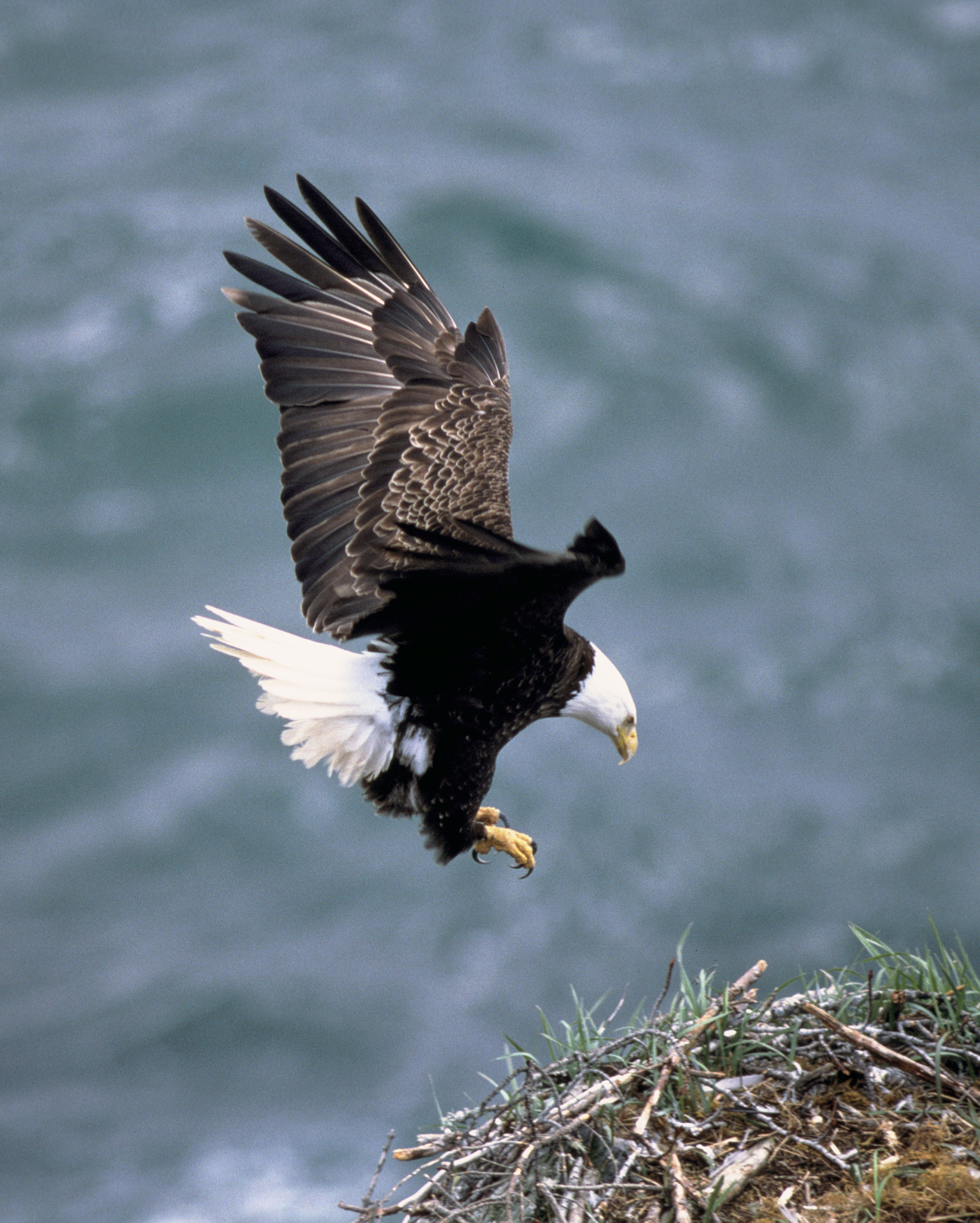- Sea eagle
image_caption =Bald Eagle
("Haliaeetus leucocephalus")
image_width = 300px
regnum =Animal ia
phylum = Chordata
classis = Aves
ordo =Falconiformes
familia =Accipitridae
genus = "Haliaeetus"
genus_authority = Savigny, 1809
subdivision_ranks =Species
subdivision = "Haliaeetus leucogaster "
"Haliaeetus sanfordi "
"Haliaeetus vocifer "
"Haliaeetus vociferoides "
"Haliaeetus leucoryphus "
"Haliaeetus albicilla "
"Haliaeetus leucocephalus "
"Haliaeetus pelagicus "A sea eagle (also called erne or ern) is any of a group of birds of prey in the
genus "Haliaeetus" [Etymology :New Latin "sea-eagle", fromAncient Greek [http://archimedes.fas.harvard.edu/cgi-bin/dict?name=lsj&lang=el&word=a%28lia%2fetos&filter=CUTF8 polytonic|ἁλιάετος ("haliaetos") or polytonic|ἁλιαίετος ("haliaietos", poetic variant)] , "sea-eagle, osprey" ("hali-", sea, + "aetos", "eagle"). The two variant Greek forms lie behind the equally correct Latinizations "haliaetus" (as inPandion haliaetus ) and "haliaeetus".] in thebird of prey familyAccipitridae .Sea-eagles vary in size, from the Sanford's Fish-eagle averaging 2–2.7 kg to the huge
Steller's Sea-eagle weighing up to 9 kg.del Hoyo, J., Elliott, A., & Sargatal, J., eds. (1994). "Handbook of the Birds of the World" Vol. 2. Lynx Edicions, Barcelona ISBN 84-87334-15-6.] At up to 6.9 kg, the White-tailed Eagle is the largest eagle in Europe. Bald Eagles can weigh up to 6.3 kg, making them the second largest eagle native to North America. The White-bellied Sea-eagle can weigh up to 3.4 kg.Three obvious
species pair s exist; White-tailed and Bald Eagles, Sanford's and White-bellied Sea-eagle, and the African and Madagascar Fish-eagles.Wink, M., Heidrich, P., & Fentzloff, C. (1996). A mtDNA phylogeny of sea eagles (genus "Haliaeetus") based on nucleotide sequences of the cytochrome "b" gene. "Biochemical Systematics and Ecology" 24: 783-791. DOI|10.1016/S0305-1978(96)00049-X [http://www.uni-heidelberg.de/institute/fak14/ipmb/phazb/pubwink/1996/20_1996.pdf PDF fulltext] ] Each of these consists of a white- and a tan-headed species, and the tails are entirely white in all adult "Haliaeetus" except Sanford's, White-bellied, and Pallas's."Haliaeetus" is possibly one of the oldest genera of living birds. A
distal lefttarsometatarsus (DPC 1652) recovered from earlyOligocene deposits ofFayyum ,Euzbakistan (Jebel Qatrani Formation , c.33 mya) is similar in general pattern and some details to that of a modern sea-eagle.Rasmussen, D., Tab, O., Storrs, L., & Simons, E. L. (1987). Fossil Birds from the Oligocene Jebel Qatrani Formation, Fayum Province, Egypt. "Smithsonian Contributions to Paleobiology" 62: 1-20. [http://www.sil.si.edu/smithsoniancontributions/Paleobiology/pdf_hi/SCtP-0062.pdf PDF Fulltext] (file size 8.1 MB)] The genus was present in the middleMiocene (12-16 mya) with certainty.Lambrecht, K. (1933). "Handbuch der Palaeornithologie". Gebrüder Bornträger, Berlin.]Their closest relatives are the fishing-eagles in the genus "
Ichthyophaga ", very similar to the tropical "Haliaeetus" species. The relationships to other genera in the family are less clear; they have long been considered closer to the genus "Milvus " (kites) than to the true eagles in the genus "Aquila" on the basis of their morphology and display behaviour,Brown, L. H, & Amadon, D. (1968). "Eagles, Hawks and Falcons of the World". Country Life Books, Feltham.] more recent genetic evidence agrees with this, but points to them being related to the genus "Buteo " (buzzards) as well, a relationship not previously thought close.The origin of the sea-eagles and fishing-eagles is probably in the general area of the
Bay of Bengal . During theEocene /Oligocene , as theIndian subcontinent slowly collided withEurasia , this was a vast expanse of fairly shallow ocean; the initial sea-eagle divergence seems to have resulted in the fourtropical (andSouthern Hemisphere subtropical ) species found around theIndian Ocean today. TheCentral Asia n Pallas's Sea-eagle's relationships to the othertaxa is more obscure; it seems closer to the threeHolarctic species which evolved later and may be an early offshoot of this northward expansion; it does not have the hefty yellow bill of the northern forms, retaining a smaller darker beak like the tropical species.The rate of
molecular evolution in "Haliaeetus" is fairly slow, as is to be expected in long-lived birds which take years to successfully reproduce. In themtDNA cytochrome "b" gene, amutation rate of 0.5-0.7% per million years (if assuming an Early Miocene divergence) or maybe as little as 0.25-0.3% per million years (for a Late Eocene divergence) has been shown.A 2005 molecular study showed the genus is paraphyletic and subsumes "
Ichthyophaga "; the species diverging into a temperate and tropical group. [http://www-personal.umich.edu/~hlerner/LM2005.pdf]References
Wikimedia Foundation. 2010.

